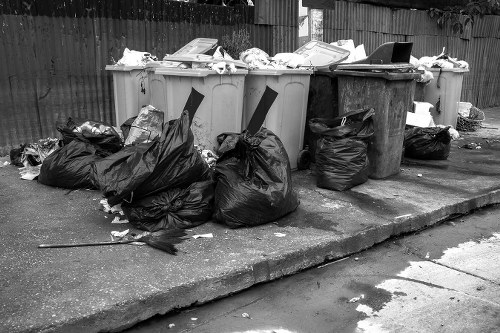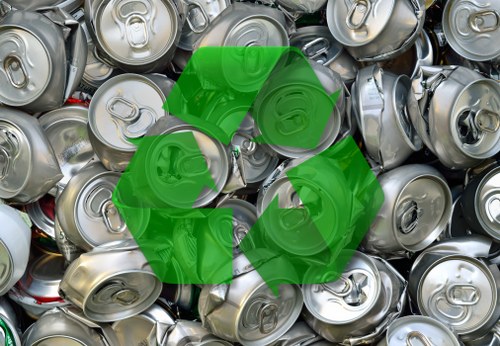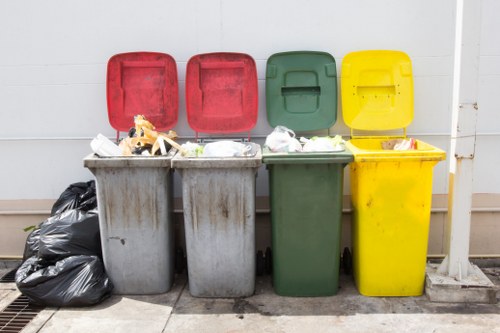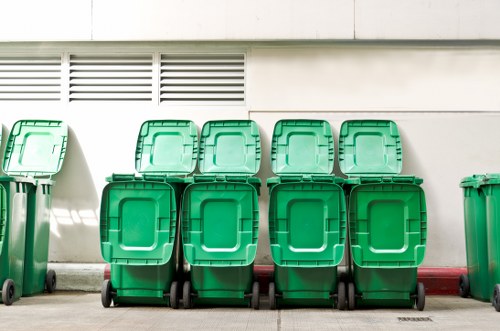Builders Waste Clearance in Waste Removal London
Introduction to Builders Waste Clearance

In the bustling city of London, construction projects are a common sight. However, with the rise in building activities comes the challenge of managing the resulting waste. Effective builders waste clearance is essential to maintain a clean and safe environment on construction sites.
Builders waste includes a variety of materials such as concrete, wood, metals, and packaging. Proper disposal ensures that these materials do not harm the environment and that construction projects proceed smoothly without unnecessary delays.
Understanding the intricacies of waste removal in London is crucial for builders and contractors. It not only ensures compliance with local regulations but also contributes to sustainable building practices.
The Importance of Efficient Waste Removal

Efficient waste removal plays a pivotal role in the success of any construction project. It helps in maintaining a safe working environment, reduces the risk of accidents, and ensures that the construction site remains organized.
Moreover, proper waste clearance can significantly impact the project's timeline and budget. Delays in waste removal can lead to project overruns, increased costs, and potential legal issues if regulations are not adhered to.
In London, waste removal services are tailored to meet the specific needs of construction projects, ensuring that waste is managed effectively and responsibly.
Types of Builders Waste

Builders waste is categorized into several types, each requiring specific handling and disposal methods. Understanding these categories helps in planning the waste clearance process efficiently.
Construction and Demolition Waste
This includes materials like concrete, bricks, timber, and metals. These materials are often bulky and require specialized disposal methods to ensure they do not harm the environment.
Hazardous Waste
Certain construction activities generate hazardous waste, such as paints, solvents, and asbestos. Proper handling and removal of hazardous waste are critical to prevent environmental contamination and ensure worker safety.
General Waste
General waste encompasses non-hazardous materials like packaging, plastics, and other miscellaneous items. While not as problematic as hazardous waste, proper disposal is still necessary to maintain cleanliness and compliance.
Steps in the Waste Removal Process

The waste removal process involves several key steps to ensure that waste is managed efficiently and responsibly. Here’s a breakdown of the typical process:
- Assessment: Evaluating the type and volume of waste generated.
- Collection: Gathering the waste from the construction site.
- Segregation: Sorting the waste into different categories for appropriate disposal.
- Transportation: Moving the waste to designated disposal or recycling facilities.
- Disposal: Ensuring that the waste is disposed of in an environmentally friendly and compliant manner.
Each step requires meticulous planning and execution to ensure that the waste removal process is seamless and effective.
Benefits of Professional Waste Clearance Services

Hiring professional waste clearance services offers numerous advantages for construction projects in London. These benefits include:
- Compliance: Ensuring that all waste is disposed of in accordance with local regulations.
- Efficiency: Streamlining the waste removal process to save time and resources.
- Safety: Reducing the risk of accidents and ensuring a safer working environment.
- Environmental Responsibility: Promoting sustainable practices by recycling and properly disposing of waste.
- Cost-Effective: Preventing potential fines and reducing overall project costs through efficient waste management.
These benefits not only enhance the overall efficiency of construction projects but also contribute to a positive reputation for builders and contractors.
Choosing the Right Waste Removal Service
Selecting an appropriate waste removal service is crucial for the success of any construction project. Here are some factors to consider when making this important decision:
Experience and Expertise
Look for companies with a proven track record in builders waste clearance. Experienced companies are more likely to handle waste efficiently and comply with all regulations.
Range of Services
Ensure that the waste removal service offers a comprehensive range of services, including collection, transportation, and disposal of various types of waste.
Environmental Commitment
Choose services that prioritize recycling and environmentally friendly disposal methods. This not only benefits the environment but also aligns with sustainable building practices.
Cost Transparency
Transparent pricing without hidden fees is essential. Request detailed quotes and compare them to ensure you are getting value for your money.
Customer Support
Reliable customer support ensures that any issues or concerns are addressed promptly, contributing to a smooth waste removal process.
By considering these factors, builders and contractors can select a waste removal service that best fits their project needs.
Environmental Impact of Builders Waste Clearance
Effective builders waste clearance significantly impacts the environment. Proper disposal and recycling reduce the strain on landfills, conserve natural resources, and minimize pollution.
Recycling materials like metals, wood, and concrete not only reduces waste but also decreases the need for new raw materials, promoting sustainable construction practices.
Additionally, responsible waste management helps in reducing greenhouse gas emissions, contributing to a healthier planet.
Regulations and Compliance in London
London has stringent regulations governing waste removal, especially for construction projects. Compliance with these regulations is non-negotiable and ensures that projects proceed without legal complications.
Builders must be aware of the Waste Framework Directive, which outlines the principles for waste management in the UK. This includes requirements for waste segregation, recycling targets, and proper disposal methods.
Failure to comply with these regulations can result in hefty fines, legal issues, and damage to a company’s reputation.
Cost Factors in Builders Waste Clearance
The cost of builders waste clearance in London depends on various factors. Understanding these can help in budgeting and selecting the right service provider.
- Volume of Waste: The greater the volume, the higher the cost. Accurate assessment helps in obtaining precise quotes.
- Type of Waste: Hazardous waste requires specialized handling and disposal, increasing costs.
- Location: Accessibility of the construction site can affect transportation costs.
- Frequency of Collection: Regular waste removal may be more cost-effective in the long run.
- Add-Ons: Additional services like recycling or on-site sorting can influence the overall cost.
By understanding these factors, builders can make informed decisions to manage costs effectively while ensuring efficient waste clearance.
Innovations in Waste Removal Technology
The waste removal industry is continually evolving with advancements in technology. These innovations enhance efficiency, reduce costs, and minimize environmental impact.
Automated Sorting Systems
Automated systems improve the accuracy of waste segregation, ensuring that recyclable materials are efficiently processed and separated from general waste.
Electric and Hybrid Vehicles
The adoption of electric and hybrid vehicles in waste transportation reduces carbon emissions, contributing to greener construction practices.
Smart Waste Management Solutions
Integrating IoT and smart technologies enables real-time tracking of waste, optimizing collection routes, and improving overall waste management efficiency.
These technological advancements are reshaping the way waste removal services operate, making them more sustainable and efficient.
Case Studies: Successful Waste Clearance Projects in London
Several construction projects in London have successfully implemented efficient waste clearance strategies, setting benchmarks for the industry.
Project A: Sustainable High-Rise Building
This project prioritized recycling and waste segregation, resulting in a significant reduction in landfill waste and promoting sustainable construction practices.
Project B: Residential Complex Development
By partnering with a professional waste removal service, this project achieved timely waste clearance, preventing site delays and maintaining project schedules effectively.
These case studies exemplify the benefits of effective builders waste clearance and highlight best practices for future projects.
Challenges in Builders Waste Clearance
Despite advancements, builders waste clearance faces several challenges in London. Addressing these challenges is essential for improving waste management practices.
- Space Constraints: Urban construction sites often have limited space for waste storage, necessitating efficient clearance systems.
- Regulatory Compliance: Keeping up with evolving regulations requires continual adaptation and training.
- Recycling Limitations: Not all waste materials can be recycled, leading to increased landfill dependency.
- Cost Management: Balancing cost with effective waste management services remains a significant challenge.
- Public Awareness: Increasing awareness about sustainable waste practices is crucial for broader adoption.
Overcoming these challenges involves collaboration between builders, waste removal services, and regulatory bodies to develop innovative and sustainable solutions.
Future Trends in Waste Removal London
The future of waste removal in London points towards greater sustainability and technological integration. Upcoming trends include:
- Increased Recycling Initiatives: Expanding recycling programs to cover more types of materials.
- Adoption of Green Technologies: Utilizing renewable energy sources and eco-friendly vehicles for waste transportation.
- Enhanced Data Analytics: Leveraging data to optimize waste management processes and improve efficiency.
- Circular Economy Models: Promoting the reuse and repurposing of materials to minimize waste generation.
- Regulatory Enhancements: Implementing stricter regulations to ensure higher compliance and better waste management practices.
These trends are set to revolutionize the waste removal industry, making it more efficient, sustainable, and environmentally friendly.
Conclusion: The Path Forward
Builders waste clearance is an integral component of successful construction projects in London. By prioritizing efficient waste removal, builders not only comply with regulations but also contribute to environmental sustainability and project efficiency.
Partnering with professional waste removal services ensures that waste is managed responsibly, promoting a cleaner and safer environment for all. As the industry evolves, embracing new technologies and sustainable practices will be key to overcoming challenges and achieving long-term success.
Contact us today to ensure your construction project benefits from top-tier builders waste clearance services in London. Book your service now and take a significant step towards sustainable and efficient waste management.